 |  |
By David Kier
Black and white photographs from John A. Kirchner’s 1988 book, Baja California Railways
El Triunfo viaduct photo by David Kier
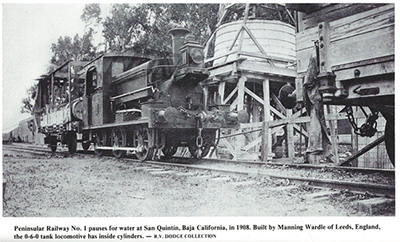
The Peninsular Railway: San Quintín 1891-1909
What grand dreams could bring such infrastructure to such a desolate region 130 years ago? Around 1885, an American (and later English) land company attempted large-scale wheat farming in the San Quintín Valley. Heavy rains in the 1880s gave a false hope for the project. A flour mill (that location is now a restaurant and motel called Molino Viejo or Old Mill), a nearby pier, and nearly 17 miles of railroad were all constructed.
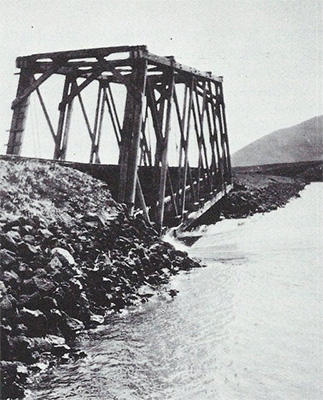
The Peninsular Railway was to eventually reach San Diego via the El Alamo gold mines. An eastern branch of the line would go through Valle de la Trinidad to reach Yuma, Arizona, where it would connect with the entire American rail network. Baja California flour would find its way to bakeries, everywhere!
A loftier goal was a south branch of this Peninsular Railroad. A railroad line connecting with the El Mármol onyx quarry and on past Bahia de los Angeles to Las Flores with its gold and silver mines. We discussed the Las Flores railroad in this article: A Desert Railroad
Alas, the rain stopped falling and the wheat did not grow without it. A couple of wet years followed by several dry ones was as typical then as it is today. The railroad project was finished before it ever got too far along.
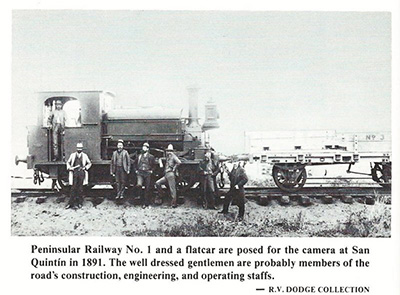
In 1909, the rails were removed and sent to be used in Arizona for a mine there. The train engine was lost, falling into the outer bay while being hoisted onto a ship. A Japanese diver was employed to attach lines to the engine but failed. The train engine lies 43 feet down, on the seafloor.
Construction of the bridge over the narrows cost the railroad far more than anticipated. In this 1908 view, the partially collapsed structure has been brought up to grade with the use of ties. The reason it crossed the bay at the Old Mill using this causeway and bridge was for a future town to be built over there. The remains of the causeway are still in place by the Old Mill Hotel. The tides keep eating away at the rocks that created it.
The Progreso Mining Company: El Triunfo Railroad 1895-1918
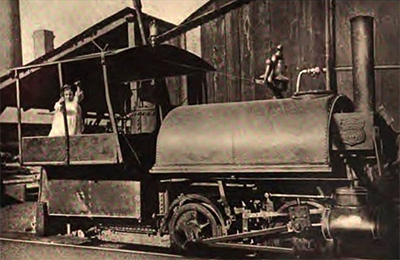
The first commercial mining on the peninsula began in the hills south of La Paz, in the mid-1700s. These were the silver mines of Santa Ana and followed by those at San Antonio. Read the full story about the first mine in Baja California here.
When the silver production dropped at San Antonio, new mines were opened near El Triunfo and in 1862. A San Francisco-based company town was born. Ownership changed a few times during its history. In 1878, it was the Progreso Mining Company’s turn. The 1880s proved to be the best years for El Triunfo silver profits. Up to $40,000 dollars a month in bullion was shipped to San Francisco, coming from the 25 to 30 miles of underground mine tunnels.
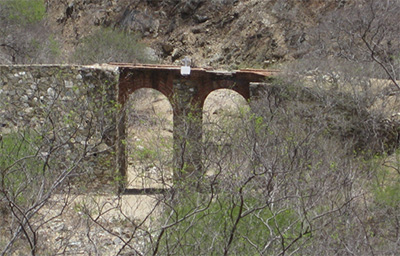
Mining and railroad operations were closely matched to the the price of silver. If not for some concessions with the Mexican governemnt during the 1890s, El Triunfo would have never had a steam locomotive. Mule driven ore carts preceded the arrival of the steam engines, shipped from from Nevada.
Nine miles of track once connected the smelter in El Triunfo with the silver mines to the northeast. There was brief hope of a connecting El Triunfo’s railroad with La Paz and Todos Santos. The idea was shelved in 1895 when the lack of available labor was made apparent. Following a decline in mining production, the Progreso company was sold in 1912. A hurricane in 1918 flooded the mines and partially destoyed the operation. Most of the tracks were sold to Japanese dealers in the 1930s. The stone bridges remain today to show visitors evidence of another one of Baja California’s railroads.
About David
David Kier is a veteran Baja traveler, author of 'Baja California - Land Of Missions' and co-author of 'Old Missions of the Californias'. Visit the Old Missions website.